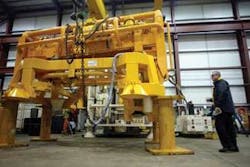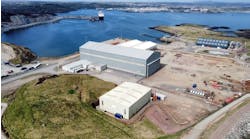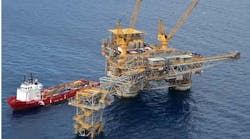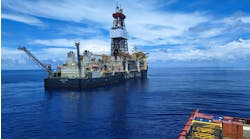Ted Moon, Houston
Aker Kvaerner reports subsea boosting success
Aker Kvaerner’s pilot installation of its MultiBooster technology for CNR International has begun operation on the Lyell field on the UK Continental Shelf. It is reported to be the first pump of its kind to be installed subsea.
“We are delighted with the performance of the Aker Kvaerner MultiBooster subsea pump,” said John Allan, project leader for CNR International in Aberdeen. “So far, it has met our expectations in terms of production capacity and performance.”
Aker Kvaerner says the MultiBooster subsea multiphase pump system increases oil recovery and enables longer step-out distances between subsea assets and host facilities by adding energy to the wellstream. This reportedly allows for a lower well-head pressure and increased production rates. The design also provides benefits when handling multiphase flow, including a wide performance envelope and high pressure boost at high gas content, the company says.
The pump system also has a capacity of approximately 150,000 b/d and uses Bornemann twin-screw internals and Aker Kvaerner’s system solution to provide what the company calls “a flexible and robust subsea solution.” The modular design of the pump system allows for easier subsea installation and retrieval.
“The highlights for this boosting technology keep coming - it is being proven on Lyell, has been awarded an OTC.06 Spotlight on New Technology Award and we are delivering three more of these subsea pumps to BP in the Gulf of Mexico,” says Raymond Carlsen, executive vice president, Aker Kvaerner Subsea.
New electrically propelled ROV
ECA Hytec, a remote-controlled intervention systems manufacturer, is launching a new work class remotely operated vehicle, the ROVH1000. The ROV has a maximum operating depth of 1,000 m and multifunctional hydraulic manipulating arms.
The electrically propelled ROV weighs 1,100 lb fully equipped (zero-weight when in water) and can handle a 35-lb payload in seawater. ECA Hytec says the open-frame design gives it exceptional modularity, especially for adding measuring sensors.
The ROV has one manipulating arm with four functions and one with five functions, as well as an embedded hydraulic power unit that the company says enables the use of a wide range of hydraulic tools. The company is particularly proud of the high quality of the ROV’s video filming and digital photo equipment.
TheH1000 has two depth configurations: the 1000-m (3000 ft.) version includes a tether management system and launching and recovery system assembly, and the 300-m (1000 ft.) version has a much lighter design and operates with a deadweight and a 400-ft. umbilical cord.
Seaeye’s small ROV goes deep
Subsea equipment supplier Seaeye has laun- ched theFalcon DR ROV to address deepwater applications to 1,000 m. Seaeye says the ROV is small but powerful, and equipped with built-in fiber optics, which will give high volume data transmission over a long umbilical and the ability to use broadcast-quality video cameras.
The design builds on previous success with Seaeye’sFalcon concept. The company has used similar ROVs in other regions with a need for compact and highly maneuverable vehicles that can be fitted with a variety of tooling options. The ROV’s open architecture makes for easy access and addition of standard tooling accessories, the company says, although additional tooling kits can be added by fitting an under-slung module.
Other benefits include five independent and brushless thrusters which respond to directional control changes quickly and accurately, and a newly introduced surface control unit, the company says. This lightweight control unit is almost half the size of earlier units, and has a fold-out 17 in. flat screen and keyboard. An optional IP68 waterproof surface control unit is available.
New subsea trees reported as MARS-friendly
Aberdeen-based DES Operations has introduced what it calls a MARS-friendly tree. The interface, designed to work with their Multiple Application Reinjection System (MARS), enables optimization of oil and gas production while minimizing the risks associated with well intervention, the company says.
DES Operations' MARS-friendly tree.
The patented MARS system optimizes production throughout the life of an oilfield, enabling processing equipment modules (pumping, metering, separation and well stimulation) to be installed on any tree at any time. According to DES, pumps can be fitted without breaking into existing subsea flowlines or re-entering the well and therefore lowers the environmental, reservoir and cost risks normally associated with deploying subsea processing equipment. “MARS can be retrofitted onto any tree, but the risk and time can be minimized and the range of applications maximized if DES verifies key dimensional information during the manufacturing phase of the christmas tree,” says DES Managing Director Ian Donald. “This is what we mean by MARS-friendly trees.”
Operators are taking notice of this new offering, the company says. BP purchased the first system for installation on the King Field in the GoM, which will enable BP to retrofit multiphase pumps to the field in water depths of 1,600 m.
The interface has most recently been supplied to Venture Petroleum by Vetco for use on the Goosander field in the UK sector of the North Sea. The specification has also been adopted by Shell and BP in the North Sea for upcoming projects.
“Flexible subsea processing has long been the holy grail of the oil and gas industry; with MARS the operators now have a simple, low risk, low cost method of achieving this,” says Donald.
Vetco Gray achieves IWIS compliance
Vetco Gray Controls has been certified as compliant with the engineering design requirements of the Intelligent Well Interface Standardization (IWIS) criteria for subsea production systems.
Long sought by the oil and gas industry, standardization of the interface between subsea control systems and intelligent well equipment is seen as a solution to delivering improved performance, reliability and flexibility and to reduce lead times and costs.
The standards for the subsea and topside interfaces was developed by an IWIS industry panel, consisting of oil and gas operators and suppliers of subsea control systems and downhole equipment.
The IWIS certification states: “Vetco Gray has successfully demonstrated compliance with IWIS for Engineering Design in accordance with ISO 13628 Petroleum and Natural Gas Industries - design and operation of subsea production systems - Part 6: subsea production control systems, and the IWIS Recommended Practice.”
Vetco Gray states that this confirms that its Subsea Control Module (SCM) can communicate with 3rd party supplied downhole sensor interfaces in compliance with the IWIS standard.
“The successful standardization of a robust solution to the interface between intelligent well equipment and downhole sensors to subsea control systems represents a significant advance in equipment integration, bringing all-round benefits,” said Gerry McCue, Vetco Gray’s VP and general manager for the eastern region.




